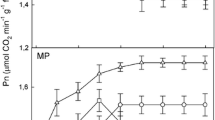Abstract
Comparison of the levels of the protein carbonyl groups in response to peroxide stress revealed enhanced stress resistance in Purpureocillium lilacinum strains isolated from soils with high content of copper or radionuclides compared to the strains isolated from uncontaminated soils. While in background strains resistance to peroxide stress increased with glucose content in the medium increasing from 0.002 to 2%, the strains from radionuclides- or copper-contaminated soils did not exhibit this pattern. Respiratory activity and polyphosphate content were compared for radiation-resistant strain 1941 and strain SM from the area with background radioactivity. For the protoplasts of strain 1941 isolated from the Chernobyl zone, elevated respiratory activity was revealed on the media with low glucose content. Under the control conditions, the content of inorganic polyphosphates (polyP) in strains 1941 and SM was the same. Under conditions of peroxide stress, only the background strain SM grown on the medium with low glucose concentration exhibited decreased levels of inorganic polyphosphates. Independent of glucose concentration in the medium, in both P. lilacinum strains polyP content increased in the course of regeneration after peroxide stress.
Similar content being viewed by others
References
Mikobiota ukrainskogo Poles’ya: posledstviya chernobyl’skoi katastrofy (Microbiota of Ukrainian Polesia) Kolosok, N.S., Ed., Kiev: Naukova dumka, 2013.
Dighton, J., Tugay, T., and Zhdanova, N., Fungi and ionizing radiation from radionuclides, FEMS Microbiol. Lett., 2008, vol. 281, no. 1, pp. 109–120.
Kulaev, I.S., Vagabov, V.M., and Kulakovskaya, T.V., The Biochemistry of Inorganic Polyphosphates, Chichester: Wiley, 2004.
Rao, N.N., Gómez-García, M.R., and Kornberg, A., Inorganic polyphosphate: essential for growth and survival, Annu. Rev. Biochem., 2009, vol. 78, pp. 605–647.
Andreeva, N.A., Ryazanova, L.P., Dmitriev, V.V., Kulakovskaya, T.V., and Kulaev, I.S., Adaptation of Saccharomyces cerevisiae to toxic manganese concentration triggers changes in inorganic polyphosphates, FEMS Yeast Res., 2013, vol. 13, no. 5, pp. 463–470.
Kudryashov, Yu.B., Radiatsionnaya biofizika (ioniziruyushchie izlucheniya): uchebnik (Radiation Biophysics (Ionizing Radiations): A Textbook), Moscow: FIZMATLIT, 2004.
Ivanova, A.E., Aslanidi, K.B., Karpenko, Yu.V., and Belozerskaya, T.A., The effect of hydrogen peroxide on the growth of microscopic mycelial fungi isolated from habitats with different levels of radioactive contamination, Microbiology (Moscow), 2005, vol. 74, no. 6, pp. 655–663.
Belozerskaya, T.A., Aslanidi, K., Gessler, N., Egorova, A., Karpenko, Yu., and Olishevskaya, S., Characteristics of extremophylic fungi from Chernobyl Nuclear Power Plant, in Current Research, Technology and Education Topics in Applied Microbiology and Microbial Biotechnology, Mendez Vilas, A., Ed., Formatex Res. Center, 2010, vol. 1, pp. 88–94.
Lushchak, V.I., Budding yeast Saccharomyces cerevisiae as a model to study oxidative modification of proteins in eukaryotes, Acta Biochim. Polon., 2006, vol. 53, no. 4, pp. 679–684.
Dalle-Donne, I., Aldini, G., Carini, M., Colombo, R., Rossi, R., and Milzani, A., Protein carbonylation, cellular dysfunction, and disease progression, J. Cell Mol. Med., 2006, vol. 10, no. 2, pp. 389–406.
Davis, R.H. and de Serres, F.J., Genetic and microbiological research techniques for Neurospora crassa, Methods Enzymol., 1970, vol. 17, p. A, pp. 79–145.
Reznick, Z. and Packer, L., Oxidative damage to proteins: spectrophotometric method for carbonyl assay, Methods Enzymol., 1994, vol. 233, pp. 357–363.
Munkers, K.D., Histochemical detection of the secretion of superoxide radicals and hydrogen peroxide by Age1 mutants of Neurospora, Fungal Genet. News Letter, 1990, no. 37, pp. 24–25.
Isakova, E.P., Deryabina, Yu.I., Gessler, N.N., Belozerskaya, T.A., and Rabinovich, Ya.M., Comparative analysis of respiratory activity in the wild type strain of Neurospora crassa and its photoreceptor complex mutants, Appl. Biochem. Microbiol., 2010, vol. 46, no. 3, pp. 318–323.
Vagabov, V.M., Trilisenko, L.V., Shchipanova, I.N., Sibel’dina, L.A., and Kulaev, I.S., Changes in inorganic polyphosphate length during the growth of Saccharomyces cerevisiae, Microbiology (Moscow), 1998, vol. 67, no. 2, pp. 153–157.
Gwin, K.R. and Battista, J.R., Ionizing radiation-resistant microorganisms, in Extremophiles: Microbiology and Biotechnology Book, Anitori, R.P., Ed., Norfolk: Caister Academic, 2012, ch. 2, pp. 25–57.
Magnani, T., Soriani, F.M., Martins, V.P., Nascimento, A.M., Tubella, V.G., Curti, C., and Uyemura, S.A., Cloning and functional expression of the mitochondrial alternative oxidase of Aspergillus fumigatus and its induction by oxidative stress, FEMS Microbiol. Lett., 2007, vol. 271, no. 2, pp. 230–238.
Aslanidi, K.B., Ivanova, A.E., Gessler, N.N., Egorova, A.S., and Belozerskaya, T.A., Comparative investigation of adaptation to the oxidation stress factors in a strain of mycelial fungus Paecilomyces lilacinus from ChAES alienation zone and the strains of the same species from areas with background radioactive contamination, Radiatsionnaya Biologiya, Radioekologiya, 2009, vol. 49, no. 4, pp. 425–431.
Author information
Authors and Affiliations
Corresponding author
Additional information
Original Russian Text © A.S. Egorova, N.N. Gessler, L.P. Ryasanova, T.V. Kulakovskaya, T.A. Belozerskaya, 2015, published in Mikrobiologiya, 2015, Vol. 84, No. 2, pp. 184–191.
Rights and permissions
About this article
Cite this article
Egorova, A.S., Gessler, N.N., Ryasanova, L.P. et al. Stress resistance mechanisms in the indicator fungi from highly radioactive Chernobyl zone sites. Microbiology 84, 152–158 (2015). https://doi.org/10.1134/S0026261715020034
Received:
Published:
Issue Date:
DOI: https://doi.org/10.1134/S0026261715020034




